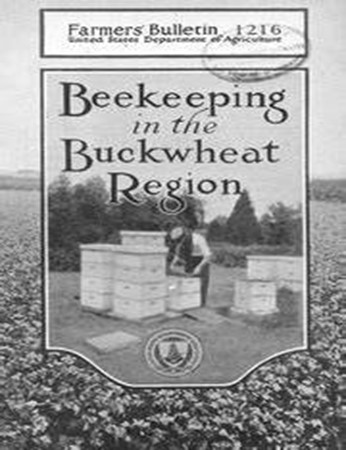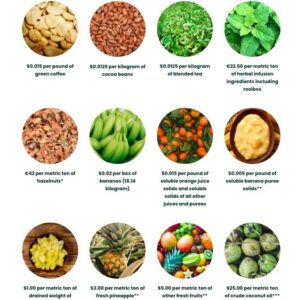ßeekeepin’ in the Buckwheat Region

ßeekeepin’ in the Buckwheat Region
THE production of the full honey crop from buckwheat requires a plan of apiary management quite different from that of most other beekeeping regions.
A system of management is here given which will result in a full honey crop and at the same time control European foulbrood, which is so prevalent in the buckwheat region.
Methods are also given which may be used in case the clovers are valuable as sources of nectar.
THE successful production of honey from buckwheat requires special and quite different methods from those applicable to a typical clover territory, since buckwheat comes into flower long after the blooming period of white clover.
Although buckwheat is now the source of a large amount of honey, estimated by Jones1 as 2.9 per cent of the total for the United States, and although some parts of the buckwheat region are at present fully stocked with bees under good management, in other parts much nectar remains Ungathered.
Many beekeepers fail to take full advantage of this source of honey because of the lateness of the honeyflow and especially perhaps because of the fact that European foulbrood is endemic in this region.
This bulletin undertakes to outline the methods which will enable the beekeepers of the buckwheat region to utilize fully this important source of honey. Wherever possible a single system is described rather than several methods for each phase of the work.
Buckwheat belongs to the same plant family as the knotweeds, or smartweeds, commonly called heartsease in beekeeping literature, and as the wild buckwheat which constitutes an important source of nectar in California. It is an introduced plant, probably native to China.
GEOGRAPHICAL BOUNDARIES OF THE BUCKWHEAT REGION.
The buckwheat region lies in the Northeastern States and extends into Canada. Two-thirds of the entire buckwheat acreage in the United States is in New York and Pennsylvania.
Buckwheat grows westward as far as Minnesota and southward in higher elevations in the Appalachian Mountains as far as North Carolina. From the beekeeping standpoint the buckwheat region is limited to those places where this species is regularly grown as a farm crop in sufficient abundance to furnish nectar for a surplus honey-crop.
This beekeeping region, therefore, lies in New York, Pennsylvania, Northeastern Ohio, Western Maryland, and est Virginia. (Fig. 1.) While this plant is grown in other States to the west of the region indicated, it is frequently a catch crop.
It has little influence on the honey crop under these circumstances and does not materially modify the plans of the beekeeper in preparing for the honeyflow.
The abundance of this species in the various sections is shown on the accompanying map (fig. 2). Zavitz3 states that the average number of acres of buckwheat in Ontario for the past 3G years has been 118,648 per annum.
In 1918 the acreage of buckwheat in the United States was as 1,027,000, an increase of 27 per cent over the average for 1912- 1916. In 1919 the acreage was 739,000.
VARIATIONS WITHIN THE REGION.
As indicated previously, this species is less valuable from the standpoint of nectar secretion in its western range because of less acreage. It appears also not to secrete nectar so freely when grown outside its optimum distribution, probably because of the special requirements of temperature, soil, and moisture in the abundant secretion of nectar in this species.
It secretes best on the Volusia and DeKalb soils, which are formed by the disintegration of shale and sandstone, especially in the glaciated plateau region of New York and Pennsylvania. It secretes best in regions where the nights are cool and the mean temperature during the blooming period does not exceed 70° F.
So far as known, the nectar is always dark in color and the resulting honey is strong in flavor. The color variation observed in the nectar of other honey plants is not observed in this species.
RELATION TO OTHER BEEKEEPING REGIONS.
The buckwheat region lies within the boundaries usually given
for the clover region, but buckwheat is found most abundant in parts of the country where white and alsike clovers are less reliable sources of nectar.
Beekeeping practices of the region are often materially modified by the presence of alsike clover, which grows on soils more acid than are suitable for the vigorous growth of red clover.
The region extends southward into the tulip-tree region, although in the southern part of the buckwheat range the area devoted to the growth of the plant often lies too high for the best development of the tulip-tree.
Where buckwheat is grown there is usually much waisted land, permitting the growth of many species of plants which furnish nectar in the fall. These, however, do not materially modify the beekeeping practices.
Buckwheat chiefly covers an area not dominated by any other valuable source of honey, and the region is therefore one in which the beekeeper will wish to choose those methods of beekeeping that will give the maximum amount of honey from this source.
These, however, do not materially modify the beekeeping practices. Buckwheat chiefly covers an area not dominated by any other valuable source of honey, and the region is therefore one in which the beekeeper will wish to choose those methods of beekeeping that will give the maximum amount of honey from this source.
CHARACTERISTICS OF BUCKWHEAT.
Buckwheat is a quick-growing annual herbaceous plant growing erect to a height of 2 or 3 feet. The root development is vigorous and extensive, although the roots have a rather delicate structure.
They are able to utilize relatively unavailable mineral foodstuffs in the soil and in this respect the plant has an advantage over other grain crops. The stems vary from one-fourth to five-eighths inch in diameter and from green to purplish red in color while fresh.
Only one stem is produced from early seed, and it branches more or less freely, permitting the plants to adapt themselves to the thickness of planting. The leaves are heart-shaped and alternate on the stems, being usually sessile. The flowers are small, white to pink in color, and are borne in racemes or panicles on flower stems arising from the bases of the leaves.
Flowers are produced in two forms in about equal numbers: In one form the stamens are long and the style short and in the other form the ratio is reversed.
This increases the probability of cross-pollination by insect visits, and it is usually believed that insect pollination is the frequent method. Only one kind of flower is produced on an individual plant, but seeds of either form give rise to plants of both types.
The ratio of these types is seemingly not influenced by differences in soil. The blooming period depends on the time of planting, the flowers first opening about five or six weeks after seeding. A
After blooming has once begun it usually continues until frost or harvest, although, as will be pointed out later, the secretion of nectar is not equal throughout this period of blooming. The seeds of the common varieties are smooth and shining, with three acute angles.
DOWNLOAD NOW “BEEKEEPIN’ IN THE BUCKWHEAT REGION” Collectors’ Item $10.99

Click the Blue Button Below to Get Instant Access.
Our 100% Money Back Guarantee:

If for any reason you decided within 30 days that “ßeekeepin’ in the Buckwheat Region” isn’t for you, simply notify us by email and we’ll gladly refund your money – no questions asked. That’s our Ironclad Guarantee!
The risk is entirely ours! You absolutely have nothing to lose!
[wpforms id=”97″]
Your Name and Email will Never Be Shared or Given to Anyone.
We keep our subscriber’s privacy sacred. We do not sell or rent your personal information to other parties. What’s more you can always unsubscribe at any time!
Warmest Regards,
Coyalita Linville
Copyright © 2023 – 2024 Sunrise-Sunset-Nature-Gardens.com. All Rights Reserved Privacy Policy – Earning Disclaimer – Terms of Use – Contact Us





